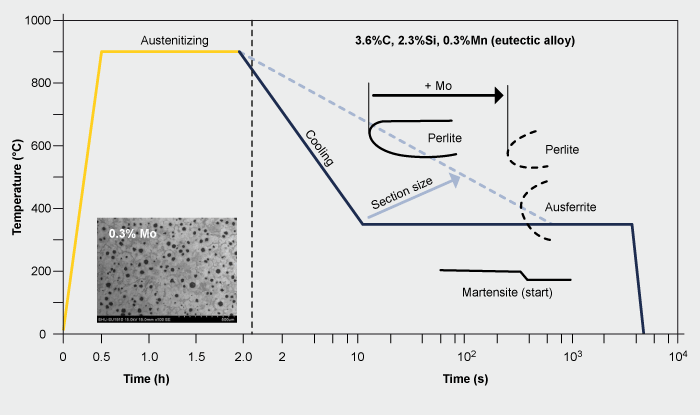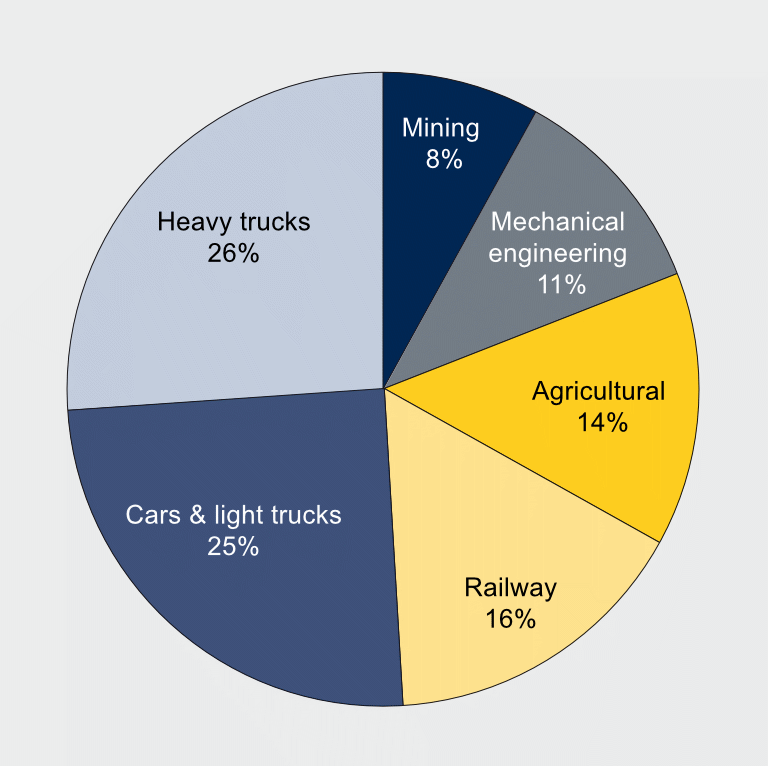Austempered ductile iron (ADI)
Advantages: high strength, toughness and elongation, high noise dampening capacity, weight savings, self-lubricating properties
Typical applications: in vehicles and railcars, large gears and crankshafts for power generation, ship propulsion, and mining equipment
Effects of molybdenum: prevents pearlite formation and thus the loss of carbon which is needed for austenite stabilization especially at lower cooling rates (heavy gaged sections), promotes hardenability
Austempering is a heat treatment where the as-cast iron matrix is reheated into austenite. The iron is then cooled from an austenitic state to an isothermal holding temperature of around 300°C. The formation of pearlite during cooling must be strictly avoided. During austempering, an increasing fraction of bainite forms, and carbon partitions to the remaining austenite phase. The highly carbon enriched austenite fraction remains meta-stable down to low temperatures. The final microstructure of austempered ductile iron (ADI) consists of bainite and retained austenite (also called ausferrite) as well as spherical graphite resulting in very attractive properties.
ADI achieves a similar strength to heat-treated steel but with a 10% lower material density. It also has high noise damping capacity and self-lubricating properties in dry contacts. Toughness and elongation are better in ADI as compared to other cast iron materials with comparable strength. ADI is therefore one of the most attractive construction materials for realizing weight reduction. The most significant use of ADI are vehicle and railway applications. Large gears and crankshafts required for power generation, ship propulsion and large mining equipment are other important applications.
Comparison of mechanical performance of ADI vs. other iron types and application areas of ADI
Molybdenum alloying is used to prevent pearlitic transformation during cooling to the austempering temperature, avoiding major capital investment in quenching facilities, especially when casting larger components. The addition of molybdenum, nickel, and copper shifts the pearlite nose towards longer times and promotes hardenability.
In general, section sizes greater than 19 mm require alloying. Alloying with manganese is not recommended because it segregates to the regions in between the graphite nodules. Manganese alloying delays the austempering reaction, resulting in martensite formation and reduced toughness. Copper additions in excess of 0.80% can create diffusion barriers around the graphite nodules and inhibit carbon diffusion during austenitizing. Nickel additions of up to 2% are both technically and economically viable.
Molybdenum is very powerful in delaying both pearlite and bainite formation, hence promoting the formation of metastable carbon-enriched austenite. However, molybdenum strongly segregates to intercellular/interdendritic locations between the graphite nodules where it can form hard undesirable Mo carbides. These carbides are especially detrimental if a component is machined after heat treatment. The molybdenum alloy content in ADI is usually limited to 0.3% for this reason.
Metallurgical principle of austempering and pearlite delaying effect of Mo




